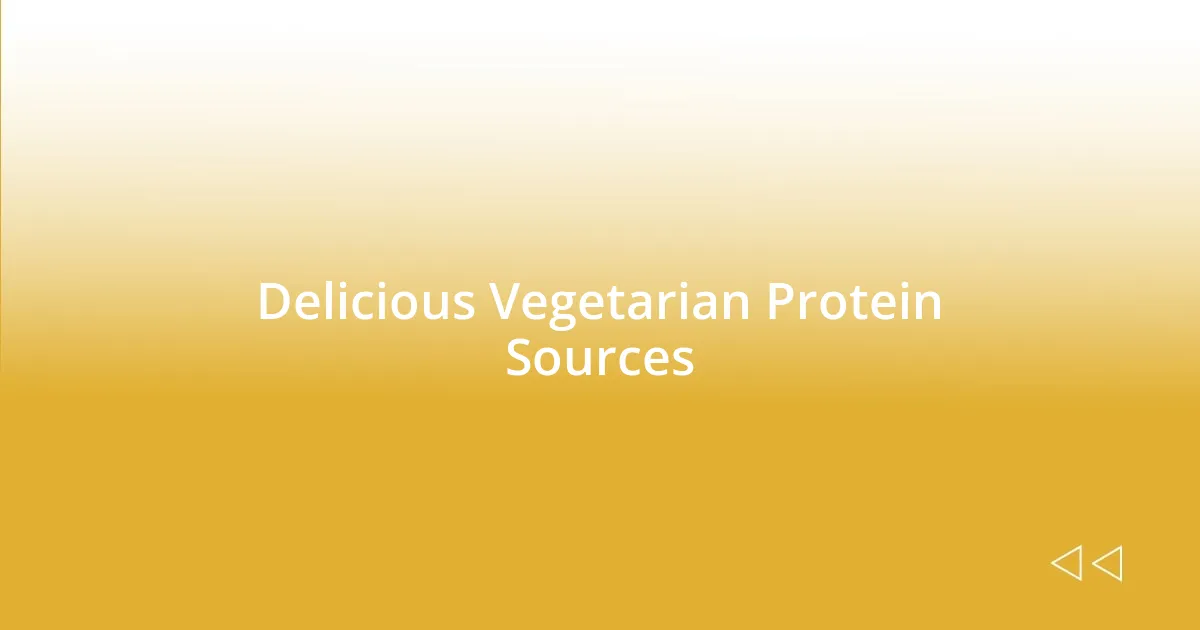Key takeaways:
- Vegetarianism leads to improved health, increased energy levels, and reduced environmental impact.
- Key nutrients for vegetarians include protein, vitamin B12, iron, and omega-3 fatty acids, with various plant-based sources available.
- Meal planning strategies like batch cooking, flexible recipes, and careful planning help enhance the vegetarian cooking experience.
- Overcoming challenges such as social situations, nutritional needs, and cravings can be managed through personal dishes, food tracking, and experimenting with alternatives.

Understanding Vegetarianism Benefits
One of the most striking benefits of vegetarianism is how it can lead to better health. Personally, since I adopted a vegetarian lifestyle, I’ve noticed improved energy levels and a decrease in digestive issues. Have you ever felt sluggish after a heavy meal? Transitioning to plant-based foods really helped me feel lighter and more energetic throughout the day.
Another key advantage is the environmental impact. I often think about how our food choices ripple throughout the planet. For instance, choosing vegetables over meat significantly reduces greenhouse gas emissions and water usage. When I learned this, I felt a sense of responsibility and empowerment—like my dinner plate could contribute positively to the world.
Lastly, vegetarianism fosters a deeper connection with food and its sources. I remember visiting a local farm for the first time; understanding where my vegetables came from changed my perspective entirely. It made me appreciate the nuances of flavors and the effort behind sustainable farming. Isn’t it fulfilling to know that the food you eat supports not only your health but also your values?

Essential Nutrients for Vegetarians
It’s essential for vegetarians to pay attention to certain nutrients that may be less abundant in a plant-based diet. For instance, protein is crucial for building and repairing tissues. I remember when I first went vegetarian, I worried about getting enough protein. I found that incorporating beans, lentils, and quinoa not only met my protein needs but also introduced me to a variety of delicious recipes I never thought I’d make!
Another vital nutrient is vitamin B12, which is primarily found in animal products. I once experienced fatigue and figured out my B12 levels were low. Now, I ensure I consume fortified foods or take a supplement. It’s fascinating how something so small can have a big effect on energy levels and overall health.
Iron and omega-3 fatty acids are also important for vegetarians. I learned that while spinach contains iron, it’s beneficial to pair it with vitamin C-rich foods like citrus fruits to enhance absorption. Including flaxseeds or chia seeds has been my go-to for omega-3s, especially when I started to notice positive changes in my skin and hair!
| Nutrient | Sources |
|---|---|
| Protein | Beans, lentils, quinoa, tofu |
| Vitamin B12 | Fortified cereals, yeast, supplements |
| Iron | Spinach, lentils, chickpeas |
| Omega-3 Fatty Acids | Flaxseeds, chia seeds, walnuts |

Meal Planning Strategies for Vegetarians
Meal planning as a vegetarian can initially feel overwhelming, but I’ve found it’s all about embracing creativity. I remember facing a week where I had so many vegetables I didn’t know what to do with them. That’s when I started creating themed meal plans, which not only simplified my grocery list but also made cooking feel like an exciting adventure. Having a structure helped me use up all my fresh produce while discovering combinations I wouldn’t have tried otherwise.
Here are some strategies that have worked for me:
- Batch Cooking: Prepare large quantities of grains, beans, or veggie dishes to have ready meals throughout the week. I often spend Sundays making big pots of soup or grain salads, which saves a ton of time later.
- Flexible Recipes: Look for versatile recipes that can change with the seasons or based on what’s in your fridge. For example, a simple stir-fry can be transformed by swapping out vegetables or adding different sauces.
- Mix and Match: Create a list of pantry staples and fresh ingredients that can be mixed together in various ways. It turned my typical “What’s for dinner?” question into a fun puzzle, like figuring out which veggies went best with my go-to rice noodle dish.
- Plan Ahead: I found that dedicating a little time each week to plan my meals not only simplifies grocery shopping but also minimizes food waste. I often jot down meal ideas in a notebook—having everything plotted out takes the stress out of last-minute cooking.
By using these strategies, I’ve gained confidence in the kitchen and can whip up meals without feeling like I’m starting from scratch each time. It’s amazing how enjoyable and efficient meal prep can become when you approach it with a plan!

Delicious Vegetarian Protein Sources
When it comes to delicious vegetarian protein sources, I’ve always found lentils to be a game-changer. They pack a whopping 18 grams of protein per cooked cup, and I love how versatile they are. Whether I’m whipping up a warm lentil soup or tossing them into a hearty salad, they add an earthy flavor that’s immensely satisfying. Have you ever tried a lentil burger? It’s surprisingly filling and can rival any meat-based option in terms of flavor!
I can’t talk about vegetarian protein without mentioning tofu. At first, I was hesitant because I didn’t know how to cook it. But once I learned to marinate it properly and sauté it until crispy, I truly fell in love. Adding tofu to stir-fries or curries not only boosts the protein content but also absorbs all the delicious flavors of the sauce. I still remember the first time I made a tofu pad Thai – my friends couldn’t believe it was plant-based!
Quinoa has also earned a special place in my heart. It’s one of the few plant foods that’s a complete protein, meaning it contains all nine essential amino acids. I often use it as a base for my grain bowls, pairing it with everything from roasted vegetables to spicy chickpeas. Every bite is comforting, nourishing, and makes me feel like I’m treating myself while staying healthy. It’s incredible how small changes in our meals can lead to such fulfilling experiences, isn’t it?

Overcoming Common Vegetarian Challenges
Transitioning to a vegetarian lifestyle often brings its own set of hurdles, especially when it comes to social situations. I vividly recall attending a friend’s barbecue, eyeing all the grilled meats while feeling a little out of place. To navigate such gatherings, I’ve learned to bring my own dish—something delicious that I know I can enjoy while also sharing with others. On that occasion, my grilled vegetable skewers became the highlight among the meaty offerings, sparking conversations and ample requests for the recipe. Have you found ways to make your vegetarian options shine in social settings?
Navigating nutritional needs can also be a bit daunting. I still remember my early days when I was unsure if I was getting enough vitamins and minerals. To tackle this, I started keeping a food diary, noting what I consumed. This simple step helped me identify any gaps in my diet. For instance, I realized I was lacking in iron, leading me to incorporate more spinach and legumes into my meals. It’s quite empowering to take control of your nutrition in this way—have you thought about tracking your intake?
Lastly, handling cravings can be another challenge when embracing vegetarianism. There were moments I craved the taste of cheese-laden comfort foods and felt a pang of longing. To overcome this, I began experimenting with dairy-free alternatives and plant-based cheeses. One of my favorites is cashew cheese, which I whip up with nutritional yeast for a satisfying, cheesy flavor. It’s incredible how a little experimentation can lead to finding substitutes that not only satisfy cravings but also introduce new flavors into your diet! What’s your go-to recipe for overcoming such cravings?

Cooking Tips for Vegetarian Meals
Cooking vegetarian meals can be a delightful journey if you focus on mastering flavors. One of my go-to techniques is layering spices and herbs throughout the cooking process rather than just tossing them in at the end. For instance, when I prepare vegetable stir-fries, I sprinkle some soy sauce and garlic while the vegetables are still crisp, allowing those flavors to meld beautifully. Have you noticed how a little attention to seasoning can elevate simple ingredients?
I also find that experimenting with textures can transform a meal entirely. The first time I made a vegetarian chili, I blended cooked beans to create a smooth base but left some whole for that hearty bite. The combination made the dish feel more complex and satisfying. At that moment, I realized that the right mix of smooth and chunky can lead to a mouthwatering experience—what textures do you like to play with in your meals?
Don’t underestimate the power of presentation! I distinctly remember a time when I served a simple vegetable pasta but took the extra effort to plate it beautifully, adding fresh basil and a drizzle of olive oil. That meal seemed to shine, and my dining companions couldn’t stop complimenting it. It reinforced to me that we eat with our eyes first; how do you make your vegetarian dishes visually appealing?

Resources for Vegetarian Inspiration
When I first sought inspiration for my vegetarian meals, cookbooks quickly became my best friend. One of my favorites, “Plenty” by Yotam Ottolenghi, opened my eyes to the color and creativity vegetables can offer. I remember flipping through its pages, feeling an excitement that made me want to rush into the kitchen and try every recipe. Have you found a cookbook that sparked your culinary creativity?
Beyond traditional cookbooks, I’ve discovered a treasure trove of ideas online. Food blogs like Minimalist Baker and Oh She Glows have been game-changers for me, offering simple yet flavorful recipes. The first time I tried a homemade cashew cream from Minimalist Baker’s blog, I felt a wave of pride wash over me. It was a whole new world of flavors that undeniably broadened my palate—what online resources have you tapped into for inspiration?
If you’re not already following vegetarian influencers on social media, I highly recommend it. Their vibrant plates and innovative ideas have inspired me countless times. I recall stumbling upon a TikTok video showcasing a savory squash and quinoa bowl, which I soon recreated and enjoyed all week. The thought of discovering a community that shares your passion can be so reassuring—who do you look up to in the vegetarian sphere for fresh ideas?















